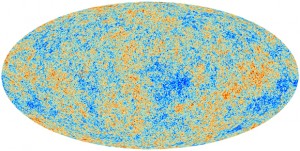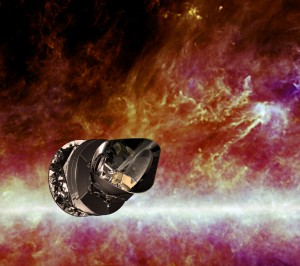
The Cosmic microwave background (CMB) as observed by Planck. The CMB is a snapshot of the oldest light in our Universe, imprinted on the sky when the Universe was just 380,000 years old. It shows tiny temperature fluctuations that correspond to regions of slightly different densities, representing the seeds of all future structure: the stars and galaxies of today. (Credit: European Space Agency and the Planck Collaboration)
The Planck Space Telescope has produced the best map ever made of the most ancient light in the Universe, with help from a Canadian team led by University of British Columbia Prof. Douglas Scott and University of Toronto Prof. J. Richard Bond.
Unveiled today in Paris, the first results of the 15-month mission show that the Universe is slightly older than previously thought, expanding more slowly and that there is more matter than known before. The data also revealed a portrait of the Universe when it was just 380,000 years old.
Led by the European Space Agency (ESA), the Planck Space Telescope has been surveying the sky since launched in 2009. The telescope’s accuracy allows it to pinpoint faint, minute patterns – differences in light and temperature that correspond to slightly different densities in the matter left over from the Big Bang.
“We now have a precise recipe for our Universe: how much dark and normal matter it is made of; how fast it is expanding; how lumpy it is and how that lumpiness varies with scale; and how the remnant radiation from the Big Bang is scattered,” said UBC’s Douglas Scott. “It is astonishing that the entire Universe seems to be describable by a model using just these six quantities. Now, Planck has told us the values of those numbers with even higher accuracy.”
Planck’s precision has also given astrophysicists a number of new puzzles to solve.
“Our maps reveal unexplained, large-scale features that excite the imaginations of physicists who have been eagerly awaiting what Planck has to say about the early Universe,” said U of T’s J. Richard Bond
BACKGROUND | THE “RECIPE” OF THE UNIVERSE
Planck’s data confirm and refine previous models of how astronomers believe the Universe originated and evolved, but with intriguing new details. The Planck team has calculated that the Universe is 13.82 billion years old—100 million years older than earlier estimates.
Planck has revealed that the Universe is expanding significantly slower than the current standard used by astronomers (known as Hubble’s Constant).
The space telescope has also allowed cosmologists to confirm the Universe’s composition more accurately than ever before: normal matter, the stuff of stars and galaxies like our own Milky Way, makes up just 4.9 per cent of the Universe.
Dark matter (an invisible substance that can only be inferred through the effects its gravity cause) accounts for 26.8 per cent. Dark energy, a mysterious force that behaves the opposite way to gravity, pushing and expanding our Universe, makes up 68.3 per cent of the Universe—slightly less than previously thought.
More about the Planck mission
A series of scientific papers from the Planck mission are scheduled to be published March 22, covering many aspects of how the Universe is put together and how it has evolved. Planck’s instruments allow astronomers to separate the primordial light from the effects of dust and other emissions coming from our Milky Way Galaxy.
Hundreds of astronomers from around the world will continue to study Planck’s data as the telescope continues its observations. The complete results of the mission are scheduled to be released in 2014 once the space telescope has completed its study of the skies.
Funding and Partners
Planck includes contributions from the Canadian Space Agency (CSA). The CSA funds two Canadian research teams that are part of the Planck science collaboration, and who helped develop both of Planck’s complementary science instruments, the High Frequency Instrument (HFI) and the Low Frequency Instrument (LFI).
The Canadian teams consist of scientists from UBC, U of T, the University of Alberta, Université Laval and McGill University.

